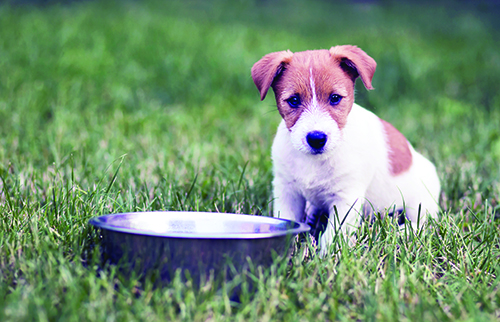Michael Pollan, author of the best-selling books on diet The Omnivore’s Dilemma, In Defense of Food, and Food Rules, once came up with the world’s most succinct guide for a healthy human diet: “Eat food. Not too much. Mostly plants.”
If only we could come up with something that simple for puppies! The advice could start in a very similar fashion: “Feed food. Not too much….” But in order for the slogan to be nutritionally sound, the next part would be far too complicated to put on a book cover or tote bag: “Mostly quality sources of animal protein, delivered at adequate levels. Same goes for fat. Not too much calcium, but enough, depending on the expected adult size of the puppy . . . .”
There’s more, but you get the idea. There are a lot of factors that have to be carefully considered when feeding puppies – that is, if you want them to grow into healthy and sound adult dogs.
On the other hand, I don’t want to scare anyone; feeding puppies isn’t rocket science. But there are a few little details that you need to attend to in order to make sure your pup grows at an appropriate rate – things that aren’t as critical with an adult dog.
STANDARD ISSUE
The differences between the nutrient requirements for puppies and those for adult dogs are laid out in tables developed by the Association of American Feed Control Officials (AAFCO); these are called the AAFCO Dog Food Nutrient Profiles, and they include the standards for what comprises the legal definition of “complete and balanced” diets for dogs. One lists the nutrient levels required for the “maintenance” of adult dogs only; the other lists the nutrient levels that meet the needs of breeding animals, pregnant or nursing females, and growing puppies. The latter is often referred to as the “growth and reproduction” nutrient profile.
These tables differ in notable ways. Puppies need higher amounts of protein (including higher amounts of many specific amino acids that contribute to the food’s total protein), fat, calcium, phosphorus, and several other minerals than the amounts needed by adult dogs. This is why you must make sure that the food you buy for your puppy (any dog less than a year old) is formulated to meet the standards for complete and balanced nutrition for growth.
Often, dog food labels say that the food contained in the package meets the standards for dogs “of all life stages.” This implicitly includes puppies. If a food is labeled as either meeting the nutrient levels or passing a feeding trial for dogs of “all life stages,” it has to meet the “growth” requirements.
Often – but not always – food that is formulated to meet the needs of puppies has the word “puppy” in the name of the food. Again, if the label indicates that it’s “complete and balanced for dogs of all life stages,” it has met the AAFCO standards for growth (puppies). But if the label says it is “complete and balanced for adult maintenance,” it is not suitable for puppies.

Where will you find this information? This is where things get weird: This statement is the most important thing to check on the label of your puppy’s food, and I will almost guarantee that it will be printed on the bag or can in teeny, tiny type. Scan the label carefully for the words “AAFCO Nutrient Profiles” or “AAFCO Feeding Trial.” The block of text containing one of these phrases will probably appear on the back or even the side of the package, and it will reference either “growth” (great!), “dogs of all life stages” (super!), or “adult maintenance” (womp, womp, no!).
CHECK THE SIZE
All puppy foods used to be formulated to meet the same nutrient standards. In recent years, however, animal nutrition experts came to understand that large-breed puppies should receive less calcium than puppies of smaller breeds to prevent their bones from growing too quickly. Excessively fast growth can result in the development of bone and joint abnormalities in large-breed puppies. So, in 2016, AAFCO began to require food makers to explicitly state whether their products contained calcium at an appropriate level for large breed puppies (defined as those pups expected to reach an adult weight of more than 70 pounds).
If the AAFCO statement says the food is for growth/all life stages “including growth of large-size dogs (70 pounds or more as an adult),” it is safe to feed to large breed pups.
If the statement says the food is for growth/all life stages “except for growth of large-size dogs (70 pounds or more as an adult),” it should not be fed to large-breed puppies.
To be safe, if you have a large-breed puppy, or a mixed-breed pup who looks like he may grow to more than 50 or 60 pounds, you should choose foods with the “including growth of large-size dogs” statement. Smaller-breed puppies can be safely fed foods with either statement.
Hallmarks of Quality
✓ Lots of animal protein at the top of the ingredients list. Plant-sourced protein is less appropriate than animal protein.
✓ When a fresh meat is first on the ingredients list, there should be a named animal-protein meal immediately or closely following the meat.
✓ Whole vegetables, fruits, grains, and/or carbohydrate sources (as opposed to food “fractions”).
Disqualifiers
* Meat byproducts, poultry byproducts, meat byproduct meal, and poultry byproduct meal.
* “Generic” fat sources (e.g., “animal fat”).
* “Animal plasma” or blood meal as a protein source.
* Added sweeteners.
* Artificial colors, flavors, or preservatives (such as BHA, BHT, ethoxyquin).
OUR USUAL CRITERIA
Once you are confident that you can identify foods that are appropriate for puppies of the size you expect your pup to be, you can search among those products for diets that meet our usual selection criteria (listed in the box below) and that are in your price range.
Check the protein and fat content of the food you are feeding your pup right now. If his weight and energy are good, try to buy only those foods that contain similar levels of protein and fat. Be aware that these levels range widely. If you start feeding him a product with double or half the protein or fat content of the food you are giving him now, you will see changes in him; his appetite, weight, stool quality, and/or energy may be affected.
Finally, don’t be afraid to try different foods. Pet food companies want to win your loyalty, but the fact is, variety is actually good for your puppy. The more you change foods, the more accustomed his digestive tract will become to a wide variety of ingredients. Also, because each manufacturer’s products contain different levels of each required nutrient (within the AAFCO specifications), by routinely switching products, you are sure to provide “balance over time” and prevent him from suffering ill effects of any potentially excessive or deficient nutrient levels.






How can you recommend to try a new food for my dog?
How you recommend to try a new food for my dog.?
Thank you for the informative post. Could you please suggest us some reliable dog food brand?
I fully understand the need for less calcium in dry food made for large-breed puppies; however, almost every bag of “large breed puppy” dry food that I’ve looked at has MORE calcium than the “regular” puppy dry food. So what am I to do??